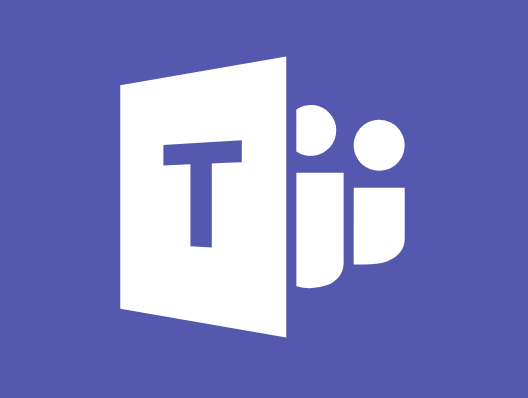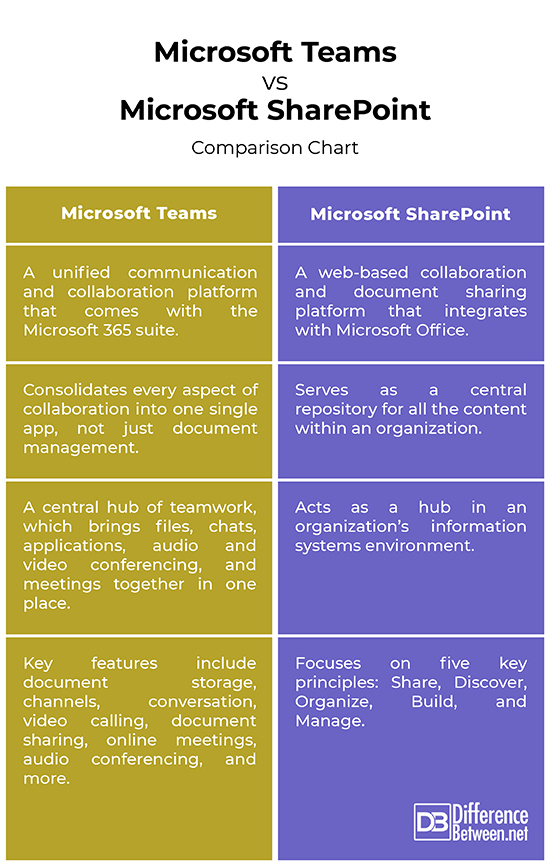Difference Between Microsoft Teams and SharePoint
Microsoft Teams is an integration of different applications and functionalities combined into one single application. However, there are few key ingredients that aids Teams to function. Every time you create a team in Teams, some items are automatically created in the background on the Microsoft’s servers, one of which is a Modern SharePoint Online site with a document library. Each channel in Microsoft Teams has a corresponding folder in SharePoint Online for the files you work with.

What is Microsoft SharePoint?
SharePoint is a web-based collaboration and document sharing platform that integrates with Microsoft Office and is primarily used to store documents, and communicate across organizations. SharePoint is nothing new. In fact, it’s been around for more than a decade. Microsoft SharePoint Portal Server 2001 was the first version to use the SharePoint brand name. Its humble beginnings were in web-based document management and collaboration sites. SharePoint should be a thing of the past by now. However, its capabilities have grown over the years and SharePoint has finally found its legs after so many years. SharePoint is now an enterprise-ready, cloud-capable platform providing many different types of capabilities and services. SharePoint products and technologies are a major part of the Office suite. In fact, SharePoint is the backbone of the Office System because it connects users to the Office Suite. SharePoint empowers teamwork by providing a self-service environment where teams can communicate and work together.

What is Microsoft Teams?
Teams is a business communication and collaborative application developed by Microsoft as part of its family of Microsoft 365 suite of products. Teams make it easy to manage your teams (employees) in an increasingly connected and distributed world. Teams is a central hub of teamwork, which brings files, chats, applications, audio and video conferencing, and meetings together in one place. Teams is mostly inspired from the DNA of Skype for Business; in fact, Teams is officially replacing the Skype for Business client, finally retiring the years-old communication platform. Microsoft Teams is not just a collaboration platform; it is a complete package that provides everything from document sharing capabilities to online meetings, screen sharing, full telephony, live captioning, and much more. Teams is available either as a stand-alone downloadable app or as part of the Microsoft 365 bundle. You can also sign up for free without buying the Microsoft 365 bundle, but you won’t get all the benefits and functionalities of the full-fledge Microsoft Teams application.
Difference between Microsoft Teams and SharePoint
Platform
– SharePoint is a web-based collaboration and document sharing platform that integrates with Microsoft Office and is primarily used to store documents, and communicate across organizations. Microsoft Teams, on the other hand, is a unified communication and collaboration platform that comes bundled with the Microsoft 365 suite of products. However, Teams is much more than that; it consolidates every aspect of collaboration into one single app, not just document management. SharePoint serves as a central repository for all the content within an organization.
Access
– SharePoint sites are accessed via your Internet browsers, such as Chrome, Firefox, Internet Explorer and Safari. You can sign in to Microsoft 365, or your organization’s corporate SharePoint Server site and click SharePoint to access it. SharePoint is mostly used by organizations to create websites. Microsoft Teams, on the other hand, can be accessed via a standalone app that can be downloaded for both Android and iOS devices. It also comes bundled with the Microsoft 365 suite, so you can just sign in with your Microsoft 365 username and password to access Teams.
Role
– SharePoint has a significant role in this already crowded information systems environment. It aims to be the missing link in an organization’s information systems environment by acting as the hub. It is an integral player in providing users access to information assets. Whether its file shares, email Inboxes, and databases, SharePoint provides its own set of repositories to create manageable information environments. Microsoft Teams, on the other hand, is a central hub of teamwork, which brings files, chats, applications, audio and video conferencing, and meetings together in one place. All the files shared in Teams are stored in SharePoint Online.
Pricing
– For small and mid-sized businesses, SharePoint offers a SharePoint Online Plan 1 which costs only $5 a month for one user, if you commit to the annual plan. There is a SharePoint Online Plan 2 which is a full-featured application with enterprise ready capabilities and features and which costs $10 per user per month (annual plan). Microsoft Teams is available in two distinct plans: the fee plan and the paid version. The Free plan is free for everyone and the paid version is included in the Microsoft 365 Business plans, which starts at $5 per user per month and goes up to $12.50 per user month. Then there is the Office 365 E3 bundle that includes both SharePoint Online and Microsoft Teams and costs $20 per user per month.
Microsoft Teams vs. Microsoft SharePoint: Comparison Chart

Summary
When creating a team, one of the components it creates is a Modern SharePoint Online site with a document library. All the files shared in Teams are stored in SharePoint Online. SharePoint Online must be active to work with Microsoft Teams. With SharePoint, companies can create a managed information environment that is not centrally managed. Companies can use SharePoint to integrate information about campaigns, achievement of performance objectives, and company news into employees’ daily routines. SharePoint empowers teamwork by providing a self-service environment where teams can communicate and work together. Teams is much more than SharePoint; it is a hub of teamwork that banks on effective collaboration across organizations. Teams make it easy to manage your teams (employees) in an increasingly connected and distributed world.
- Difference Between Caucus and Primary - June 18, 2024
- Difference Between PPO and POS - May 30, 2024
- Difference Between RFID and NFC - May 28, 2024
Search DifferenceBetween.net :
Leave a Response
References :
[0]Shadravan, Darvish et al. Microsoft SharePoint 2013 Inside Out. Washington, United States: Microsoft Press, 2015. Print
[1]Williams, Vanessa L. Microsoft SharePoint 2007 For Dummies. New Jersey, United States: John Wiley & Sons, 2011. Print
[2]Hillier, Scot P. Microsoft SharePoint: Building Office 2003 Solutions. New York, United States: Apress, 2006. Print
[3]Withee, Rosemarie. Microsoft Teams For Dummies. New Jersey, United States: John Wiley & Sons, 2020. Print
[4]Hubbard, Meliss and Matthew J. Bailey. Mastering Microsoft Teams: End User Guide to Practical Usage, Collaboration, and Governance. New York, United States: Apress, 2018. Print
[5]Image credit: https://en.wikipedia.org/wiki/SharePoint#/media/File:Microsoft_Office_SharePoint_(2018%E2%80%93present).svg
[6]Image credit: https://commons.wikimedia.org/wiki/File:Microsoft-teams.jpg
